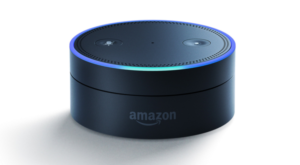
There are few technologies being more rapidly adopted and expanded in 2018 than voice AI. In just a few years, the use of voice systems has evolved from simple voice commands to entire ecosystems of applications and interactions. Furthermore, smart speakers such as Amazon Echo, Apple Home Pod and Google Home provide numerous entertainment options inside the home and add a new dimension to tasks traditionally limited to a screen. Whether you want to play some tunes, read a book or organize your to-do list, all you have to do is turn to your smart speaker and ask.
We’ve only begun to predict the ways voice AI will influence interactions between humans and technology in the decades to come. Hardware and software improvements alike are rapidly improving the ability of devices to pick up on and understand human language, allowing devices to get more accurate at predicting human behavior and more flexible in providing ways to get things done. Voice assistants are easier than ever to cooperate with, which speaks to the astonishing rate at which voice AI is finding its place in users’ daily lives and habits.
We can compare the rise of voice AI to the adoption of smartphones, which has transformed from a novelty to an essential tool over the past 10 years. Initially, smartphones were just cell phones with the added capability to surf the web. The combination was groundbreaking at the time because people had never imagined a phone would be able to cater to such diverse needs. Over the next few years, a consistent stream of innovative new features were added to smartphones as they swallowed the features of other devices, including cameras and GPS devices.
In 2018, we’re witnessing the same explosion in applications for voice AI.
The same way that the App Store (followed by Google Play and Microsoft Store) made custom smartphones apps possible, Amazon has made customizable voice apps possible with the introduction of programmable Alexa apps. New apps on Alexa allow users to manage their lives and homes with the ease of simple voice commands. For example, August Smart Lock allows you to enable an Alexa skill to check with Alexa whether your front door is locked. As voice assistants become increasingly prevalent, the way we interact with voice AI is expected to evolve in new and exciting ways, as smartphone apps have.
Here’s one example: Due to the low barrier of use for an AI voice assistant, an item’s point of sale can move closer to the point of need. In the current age of e-commerce, user behavior dictates that the purchasing of multiple items often occurs all at once — hence the need for a “shopping cart” on Amazon. In an environment where there is some cost of time to a shopper, this behavior makes sense. However, this can change through the advent of voice AI, with its lower barrier to engagement. With the ubiquity of AI assistants in every room, consumer behavior may shift to verbally purchasing items through smart speakers as they realize they’re running low rather than creating a shopping list and then purchasing them all later on a smartphone or a laptop.
Whereas smartphone products mostly assume that the user needs to have their hands free to interact with the screen, voice products assume that the user does not. This means that AI voice assistant experiences that integrate into physical tasks may be a new mode of user acquisition and engagement. One possibility in the health care space is self-directed physical and occupational therapy done through AI voice assistants. A smartphone would be a poorly suited format for engaging a user during a physically demanding task like exercise or physical motion. Physician burnout from handling mass amounts of e-paperwork can potentially be reduced with voice assistants like Suki, which listens to interactions between doctors and patients and converts the conversation into medical and billing terms, creating a clean EHR.
Finally, the changing context of user environments warrants some extra thought. In a survey by Edison Research and NPR, 39% of respondents indicated they’re very interested in having smart speaker technology in their televisions and 24% want it in their cars — two environments that are not conducive to heavy smartphone engagement. AI voice assistants unlock a mode of interaction that can coincide with these environments, creating a new way for organizations and companies to interact with users. An AI voice assistant that persists from the home to the car now opens up a new window of access to consumers who may want to buy a few more items that they forgot to purchase while looking through their kitchen earlier. While stuck in traffic, a user may see a physical advertisement that they can now act upon. Kia and Hyundai vehicles will include built-in AI assistants with voice capabilities to help answer questions about the weather and manage functions like car temperature and locks on the doors so the driver can remain hands-free.
At Sidebench, we believe AI voice assistants will unlock a new world of user interactions and that the key to leveraging their full value will be thoughtful design to ensure they’re as relevant, ethical and useful as possible. We’re keeping our eye on the advances in voice AI and how it can help our clients interact and their users in ways that have previously been unimaginable.







